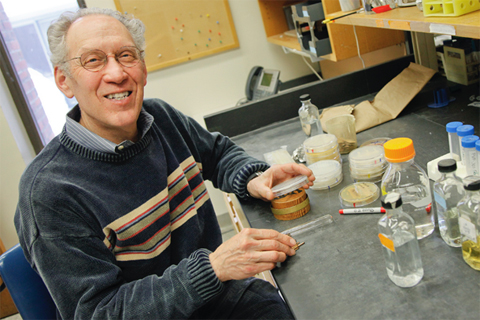New insights into DNA repair
The lab of biologist James Haber advances our understanding of these processes in a paper in the journal Nature.
 Photo/Mike Lovett
Photo/Mike LovettBiologist James Haber
A new paper in the prestigious journal Nature from Brandeis researchers in the laboratory of James Haber provides a detailed description of the processes of DNA repair.
Chromosomes undergo DNA repair to correct insults to our genetic code, caused either by errors in copying the DNA or by external factors such as exposure to radiation or toxins. Most damage gets accurately repaired, so the cell is unaffected, but some result in permanent errors (mutations or chromosome rearrangements) that may lead to diseases, including cancer. Especially dangerous are double-strand DNA breaks (DSB’s) that sever the chromosome.
The work was principally carried out by postdoctoral fellow Ranjith Anand with contributions by technician Annette Beach and physics Phd student Kevin Li. They examined repair of a double-strand break in yeast cells.
When a DSB occurs, the cell needs to patch up the break by matching up the ends of the broken chromosome with similar DNA sequences located on an intact chromosome; the intact sequences can be used as a template to repair the break by DNA copying. To accomplish repair, the cell must be able to locate another chromosome with similar sequences to use as a template.
Finding such a template is no easy task. Chromosomes are made up of base pairs — pairings of the molecules guanine and cytosine or adenine and thymine. (As you may remember from biology class, G goes with C and A with T). The end of the broken chromosome must be compared with millions of possible short DNA regions in order to find a chromosome with the same arrangement of base pairs. This search is mediated by the RAD51 protein, which promotes the matching up of the broken end with potential donor sequences.
But how perfect does the match have to be? Ranjith Anand, the first author on the Nature paper, said this was one of the central questions that the Haber lab wanted to answer.
They found that repair was still possible when every sixth base in a stretch of about 100 bases was different. Previous studies of RAD51 in the test tube had suggested that the protein had a much more stringent requirement for matching.
That one of the six base pairs could be a mismatch surprised the scientists. The process “is permissive of mismatches during the repairing,” says Anand, now an organism engineer at Ginkgo Bioworks in Boston.
There was another big surprise in the lab’s results. Researchers had thought that mismatches such as an adenine paired with a cytosine were corrected by what are called mismatch repair proteins such as MSH2 or MSH6 whereby the cytosine was removed and replaced by the properly-paired thymine. Instead, Haber and his fellow researchers found an enzyme called DNA polymerase delta serves this proofreading function.
The research was funded by the NIH.
Categories: Research, Science and Technology





